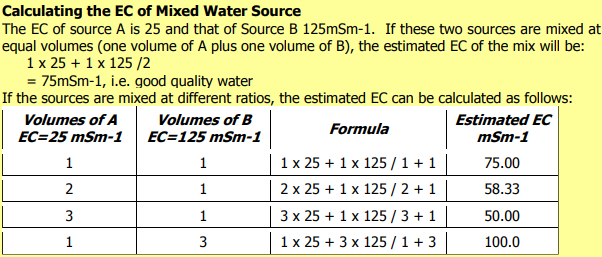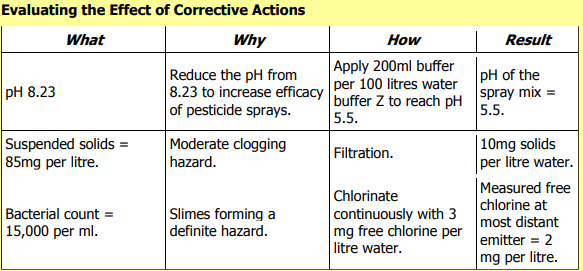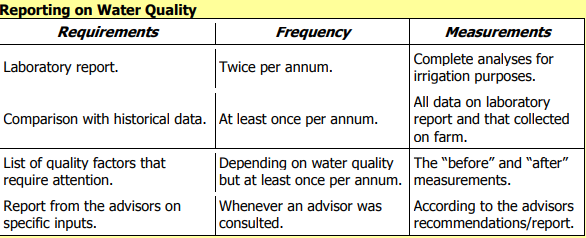Corrective Actions on Water Quality, Supply and Integrity
The actions to improve the quality of irrigation water are limited to filtration, disinfection and acidification. At this stage, the most important quality factor, the EC or total dissolved solids, can not be improved economically. We can add to the water but, apart from the carbonates and bicarbonates, we cannot remove soluble salts from water economically. Therefore other methods are employed to make unsuitable water more suitable to increase the water supply for irrigation.
The simplest method is to mix waters of low and high salt content in order to get water with a medium, but acceptable, salt content. If the waters are mixed in equal portions (50:50) the EC of the mix will be half the sum of the two separate EC’s.

Another fairly simple method is the electron magnetic treatment of hard water. In this process, the surface tension of water is decreased by passing the water through a tube-like instrument constructed of dissimilar metals. The process adds electrons to the water which reduce the surface tension and increase the carrying capacity of the water. Equipment is available in South Africa and installation and maintenance are done according to the specifications of the suppliers.
At this stage, it is more important to deal with the salts than to desalt the water. Desalting of irrigation water is currently not cost-effective.
Recommendations for Corrective Actions
The effects of some recommendations for corrective actions can easily be evaluated, especially those with a direct influence on water quality. Adjusting the pH of the water to be applied as a pesticide spray is for instance very easy and is done by merely measuring the pH and drawing a conclusion.
The effects of other recommendations can be quite difficult to evaluate. Evaluating recommendations to counteract the high concentration of chlorides in the water requires other information, such as yield and fruit quality data.
The simplest way to do this is to list the factor to be improved (what to improve), the “before” measurement (why), the recommendation (how) and the “after” measurement (result).

A huge component of this evaluation relies on the information that necessitates the action. For instance; research results proved that pesticide A is twice as effective at pH 5.5 as at 7.00 or higher. The WQM must have access to this data supplied by a competent institution.
Recommendations to reduce the impact of the indirect effects of water quality need to be done in conjunction with the person responsible for the fertilisation and soil maintenance programs. Usually, these recommendations involve multi-disciplinary inputs and can seldom be evaluated by simplistic measurements.
Reporting on Water Quality Management Systems
The importance, frequency and scope of reporting depend on the quality of the water received on the farm or at the orchard. With good quality water, where hardly any improvements or actions to reduce the impact on the trees and soil are required, a laboratory analysis twice per annum will be sufficient. As the water quality gets worse, more attention, actions and measurements are required. Reporting then needs to be more involved and should include assessments, actions and outcomes.
A reporting system should include the following basic elements:
- The current quality of the water.
- Comparisons with previous qualities, i.e. asking the question: Is the quality deteriorating?
- Actions to improve or maintain the quality or limit the impact x Schedule for actions to be taken.
- The outcome of the actions.
Data for reporting purposes are collected on an ongoing basis according to a planned schedule. The frequency and type of measurements depend on the quality of the water, the irrigation system and soil type.

The report must be concise and short and should report in detail on quality factors that are important in terms of impact on soil, trees, environment, profitability and sustainability. A prediction of the quality of the water over the next year (short term) and five years (medium-term) should be included. If any major actions are required, this should be properly investigated and addressed in the budget.